Doodling transforms blank paper into creative magic! Try drawing spiral galaxies with swirling cosmic arms, single-line face profiles, or geometric patterns exploding from a central point. Create interconnected bubble worlds, impossible objects that trick the eye, or dreamy vistas from memory. Experiment with tiny universe micro-doodles in corners, layered mandala designs, or shadow techniques using simple hatching. Each spontaneous line and shape opens doorways to unexpected artistic adventures, waiting just beyond your pen’s first stroke.
Key Takeaways
- Create spiral galaxies by starting with a center dot and adding wavy lines, varying thickness for depth and tiny stars for detail.
- Draw geometric pattern explosions radiating from a central point using circles, triangles, and zigzags with different line thicknesses.
- Transform random blobs into characters by adding eyes, mouths, and limbs where the shape naturally suggests features.
- Design impossible objects like never-ending staircases or buildings with perspectives that defy reality.
- Visualize music through lines by using different styles for genres and varying thicknesses to represent instruments.
Spiral Galaxies: Creating Cosmic Swirls
Stardust and imagination collide when doodling spiral galaxies on paper. This spontaneous drawing technique transforms random lines into breathtaking cosmic scenes that captivate the eye!
Start with a simple dot in the center of your page—this tiny speck becomes the heart of your galaxy. From this core, let your pencil dance outward in wavy lines that spiral and twist across the paper.
Begin with that humble center dot—the cosmic seed from which your entire spiral universe will magically unfurl.
Varying the thickness creates an awesome 3D effect that looks like it’s floating right off the page! Sprinkle tiny stars and dots along these cosmic arms, connecting them with curvy strokes that show the galaxy’s swirling motion.
The coolest part? No two galaxy doodles ever look the same, making each one a totally unique universe of your own creation!
Abstract Face Profiles With Single Lines
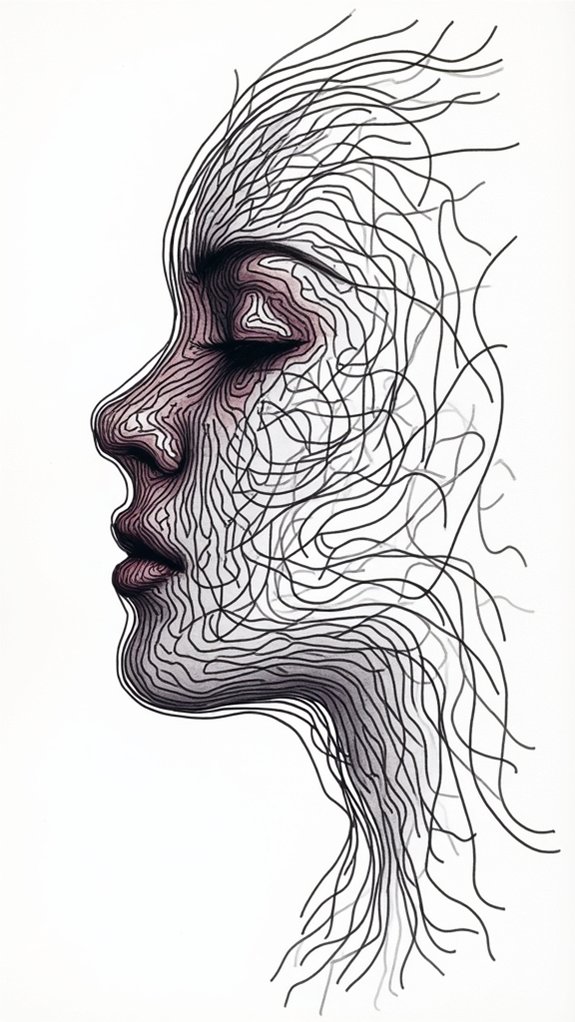
While galaxies swirl across the universe, another fascinating form of artistic expression emerges here on Earth! Abstract face profiles created with a single continuous line have become a super fun doodling technique.
Without ever lifting your pen from the paper, you can create spontaneous, flowing profiles that capture the essence of human features.
The beauty of these abstract face profiles lies in their simplicity and surprise factor. As the single line winds its way across your page, unexpected angles and proportions emerge, making each doodle uniquely yours!
Artists can play with line thickness or add tiny details like dots for eyes, while maintaining the one-line approach. This technique isn’t just cool-looking—it also improves hand coordination and pushes your creativity muscles to work in new ways!
Geometric Pattern Explosion From A Central Point
Geometric pattern explosions bring explosive energy to doodles when circular patterns expand from a single point, growing outward like ripples on water.
The layered radial harmony creates a mesmerizing effect, with each ring adding new shapes or details that work together in perfect balance.
Kids can start with simple circles and add triangles, stars, or zigzags between the rings, creating an eye-catching masterpiece that seems to jump off the page!
Expanding Circular Patterns
Countless artists and doodlers find their creativity ignited through expanding circular patterns, an enchanting technique that transforms a simple dot into an explosion of visual energy. Starting with a central point, these spontaneous drawing stock photos and illustrations are available royalty-free for inspiration. The magic happens when you add layer upon layer, creating a hypnotic ripple effect that seems to pulse off the page!
| Starting Point | Middle Layers | Outer Design |
|---|---|---|
| Simple dot | Wavy circles | Tiny triangles |
| Tiny spiral | Dashed lines | Colorful teardrops |
| Small star | Dotted rings | Bold zigzags |
| Flower center | Thick/thin bands | Shaded sections |
Try varying line thickness as you move outward—thin lines near the center, chunky ones toward the edges—for an awesome 3D effect that’ll make your doodle pop!
Layered Radial Harmony
Taking the magic of circular patterns to exciting new heights, Layered Radial Harmony transforms simple shapes into mesmerizing explosions of geometric wonder! This technique begins with a central shape, typically a circle, then radiates outward with layers of triangles, squares, hexagons, and more.
The beauty of spontaneous drawing shines here – artists can let their creativity flow as they add new elements to each layer. Varying your line thickness creates depth, while strategic color choices make the pattern pop!
The symmetry in these designs is oddly satisfying, like a perfectly balanced visual treat.
Anyone can try this technique during boring classes or meetings (we won’t tell!). Just start with that central point and let your lines expand naturally, creating a hypnotic pattern that grows more impressive with each added layer.
Layered Mandala Designs For Beginners
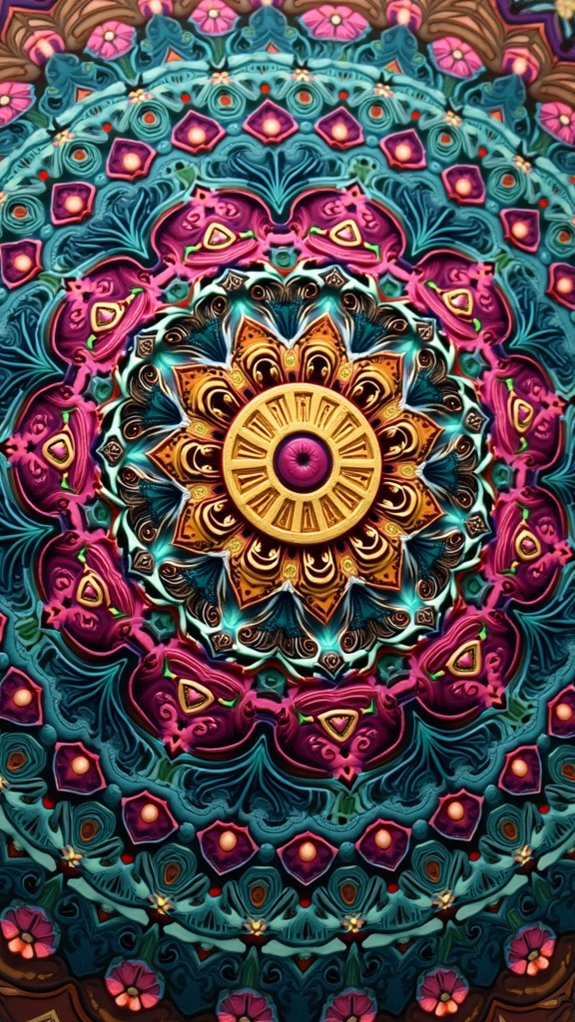
Creating gorgeous mandalas feels magical, but beginners can start with surprisingly simple shapes that bloom into stunning artwork. Perfect starting shapes include circles, triangles, and petals arranged around a central point, which serve as the foundation for increasingly complex patterns.
As beginners gain confidence, they can focus on patterning circular layers outward, repeating elements while varying thickness and detail to create depth that makes their mandala pop off the page.
Perfect Starting Shapes
The foundation of any beautiful mandala begins with simple, perfect shapes that anyone can master.
These Spontaneous Drawing royalty-free techniques create mesmerizing patterns that flow naturally from basic forms. Starting with the right shape sets the stage for a mandala that can evolve into complex designs, all available royalty-free for download in many inspiration guides.
- Circles provide the most traditional base, creating a sense of wholeness
- Squares offer stability and balance for beginners finding their style
- Triangles create dynamic energy and movement throughout the design
- Hexagons add a honeycomb-like structure that’s visually appealing
- Spirals introduce a sense of growth and evolution to your royalty-free mandala art
Each shape brings its own energy to the mandala, so choose what feels right for your mood!
Patterning Circular Layers
Layers of circular patterns form the heart and soul of stunning mandala designs that even beginners can master. Start with a small circle at the center of your page—this tiny dot is where all the magic begins!
As you add concentric circles outward, each ring becomes a playground for circular symmetry exploration and creative expression.
Try filling each layer with repeating elements like flower petals, zigzags, or diamonds. Layered shape experimentation keeps your mandala exciting and unique! Vary your line thickness to create depth, or try mandala color theory by adding complementary hues to opposite sections.
The best part? Creating these intricate patterns actually helps calm your mind while boosting creativity. Who knew that doodling circles could be so relaxing and awesome at the same time?
Interconnected Bubble Worlds

When artists seek to express interconnected ideas, Bubble Worlds offer a fascinating solution that’s both simple and endlessly creative. By drawing overlapping circles of various sizes, artists create bubble connections that flow organically across the page.
These bubbly networks invite pattern exploration while adding depth illusion through varied line thickness and strategic shading.
The dance of bubbles creates visual rhythm, inviting us to explore dimensions through simple shifts in line and shadow.
- Add tiny doodles inside each bubble for personality
- Vary bubble sizes to create visual hierarchy
- Connect bubbles with swooping lines or tunnels
- Play with color to highlight different bubble “neighborhoods”
- Use shading to make some bubbles appear to pop forward
The beauty of Bubble Worlds is their spontaneity—no planning required! Just start with one circle, then let your imagination guide where the next bubbles form.
Before you know it, you’ll have created an entire universe of interconnected shapes!
Zentangle-Inspired Pattern Blocks

Zentangle-inspired pattern blocks offer a doorway into the mesmerizing world of structured doodling, where simple shapes transform into intricate masterpieces.
Creating these patterned blocks involves dividing space into sections and filling each with repeating designs like zigzags, circles, or flowing lines.
The practice not only sparks creativity but also works like a mental massage, helping doodlers find a peaceful rhythm while their pencils dance across the paper.
Zentangle Basics
Many artists find their creative flow through Zentangle, a relaxing drawing method that transforms simple lines into stunning patterns. This mindfulness practice invites anyone, regardless of artistic experience, to create intricate designs one stroke at a time.
Zentangle techniques encourage pattern exploration while promoting creative mindfulness.
- Start with a small square tile (3.5″ x 3.5″) and divide it into sections using a pencil
- Use black ink pens to fill each section with different repeating patterns
- Focus on one pattern at a time, building complexity gradually
- Don’t worry about mistakes—there aren’t any in Zentangle!
- Experiment with shading to add depth and dimension to your patterns
The beauty of Zentangle lies in its simplicity and freedom—no erasers needed, just your imagination and a pen!
Pattern Block Construction
Every artistic journey needs a solid foundation, and pattern block construction offers exactly that! Inspired by Zentangle, this technique turns simple shapes into stunning, dynamic compositions through the power of repetition and detail.
Artists start with basic geometric forms—squares, triangles, circles—then fill each section with unique patterns like dots, waves, or stripes.
The magic happens when intricate layering transforms these simple elements into complex designs that practically pulse with energy! Kids love creating colorful contrasts between sections, making each doodle uniquely their own.
Beyond just looking awesome, pattern blocking doubles as a meditative practice that helps calm racing thoughts. When you’re lost in adding tiny details to your blocks, stress melts away as your focus sharpens.
Grab some paper and start blocking—your imagination is the only limit!
Meditative Drawing Benefits
The peaceful state of mind that occurs during pattern block creation isn’t just a happy accident—it’s actually the main attraction for many artists! When people engage in Zentangle-inspired drawing, their brains shift into a relaxed yet focused mode that delivers serious stress relief.
This mindful creativity creates a mental vacation from everyday worries while still exercising important cognitive functions.
- Heart rates actually slow down during meditative drawing sessions!
- Intricate patterns boost concentration and spatial awareness
- No pressure for perfection = freedom to create without anxiety
- Fine motor skills improve with each swirl and line
- Regular practice enhances cognitive enhancement over time
The beauty of these pattern blocks lies in their dual purpose—they’re visually stunning AND they’re like a mini therapy session for your brain. Pretty awesome for just doodling, right?
Nature-Inspired Flowing Branches
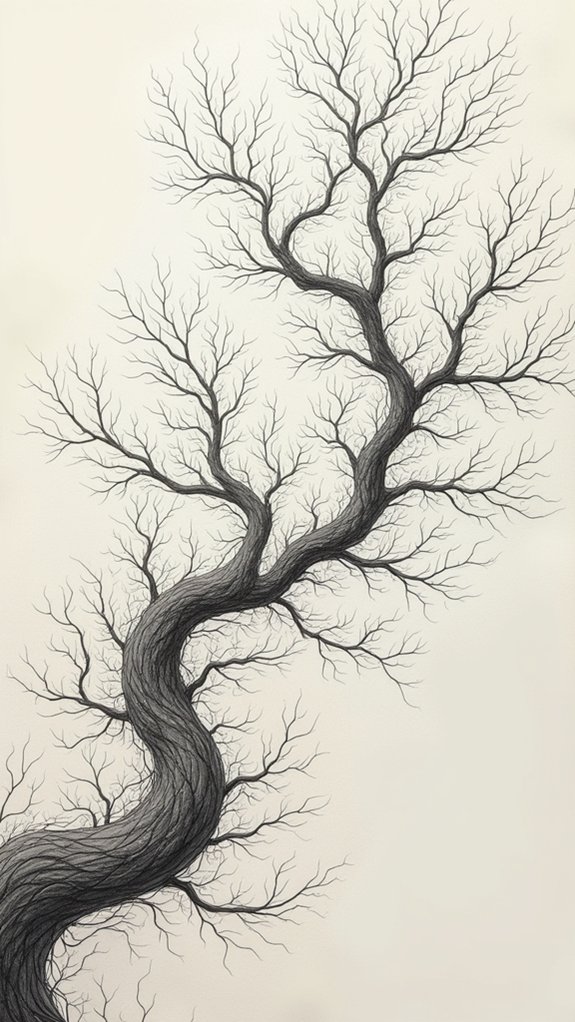
When inspiration seems elusive, turning to nature can open up a world of creative possibilities for flowing branch doodles. Artists can begin with sweeping, spontaneous lines that mimic the graceful arch of tree limbs. Through organic shape exploration, these initial strokes transform into enchanting frameworks for more detailed elements.
Branch intertwining techniques create dynamic movement across the page, resembling the fascinating ways that plants grow and reach toward light. By varying line thickness—thinner at the tips and thicker at the base—doodlers achieve greater depth and realism.
Foliage detailing methods like adding tiny leaf clusters, buds, or texture marks bring these botanical creations to life! Even a simple dot pattern can suggest blossoms or seeds, turning ordinary scribbles into miniature ecosystems full of visual interest. Nature’s patterns truly offer endless doodling adventures!
Emotional Line Art: Expressing Feelings Through Curves
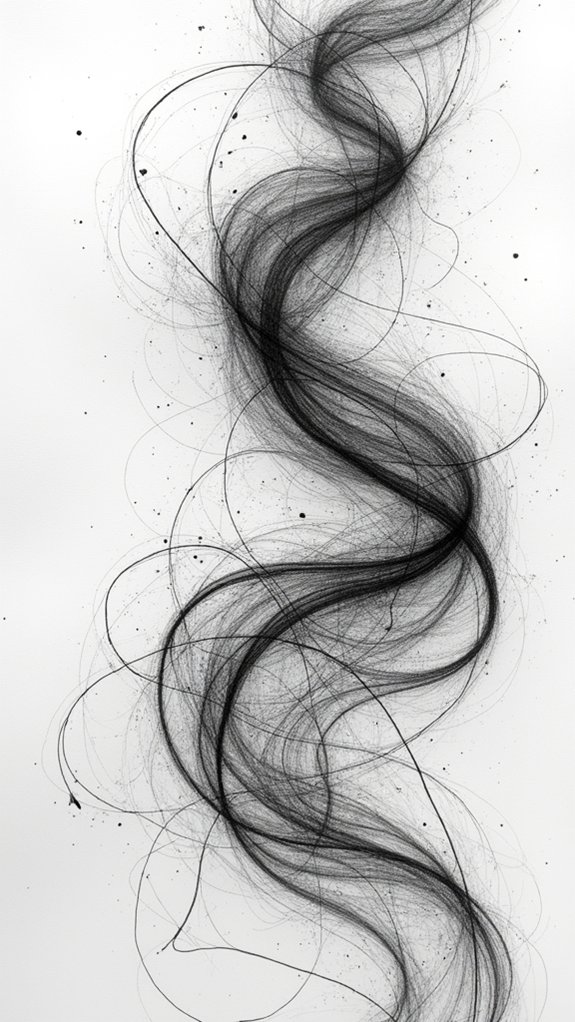
Beneath the surface of seemingly simple curves and lines, emotional line art reveals the hidden language of our deepest feelings.
Artists use this technique to transform their inner worlds into visual expressions, creating a unique emotional resonance with viewers. The power of line thickness speaks volumes—bold strokes might represent anger or confidence, while delicate lines may capture vulnerability or peace.
Line weight becomes emotional language—bold strokes shouting confidence while delicate marks whisper vulnerability.
- Doodle wavy lines when feeling calm, creating gentle ocean-like patterns
- Draw sharp zigzags for frustration or excitement—let your energy guide your hand!
- Create spirals that grow larger or smaller to show expanding or shrinking emotions
- Try closed circles for feelings of protection or open arcs for freedom
- Let your subconscious expression flow without planning—true emotional doodles are spontaneous!
Architectural Doodles: Buildings From Basic Shapes
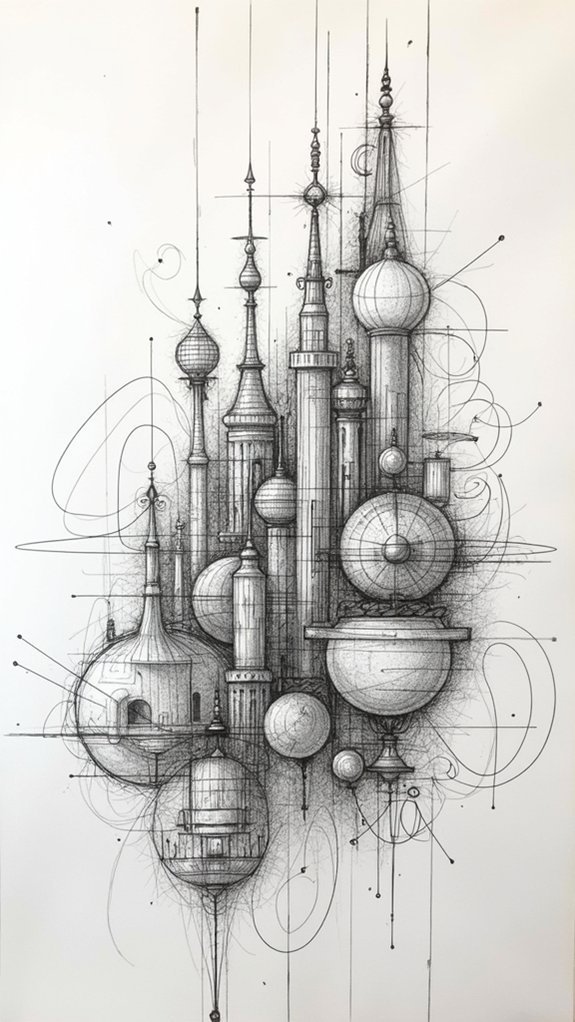
Architectural doodles come alive when you transform basic squares into stunning skylines that stretch across your page.
With just a few strokes, empty boxes become windows, pointed triangles turn into rooftops, and curved lines create dramatic arches that give your buildings personality.
Even beginners can create impressive city scenes by adding simple geometric details like fire escapes, water towers, or tiny people walking between towering skyscrapers.
Skylines From Squares
Squares and rectangles become magical building blocks in the world of architectural doodling, transforming blank paper into bustling cityscapes with just a few strokes. This technique offers artistic freedom as creators play with varying heights and widths to craft unique skyline variations.
By stacking and arranging these simple shapes, anyone can explore silhouette exploration without advanced drawing skills!
- Stack squares of different sizes to create skyscrapers and office buildings
- Layer shapes to create depth and perspective in your cityscape
- Add tiny squares for windows and details that bring buildings to life
- Experiment with spacing between buildings for a more realistic skyline
- Try drawing at sunset by adding a horizon line and simple sun shape
This beginner-friendly approach sparks creativity while providing structure, making it perfect for spontaneous doodling sessions.
Geometric City Details
When basic shapes come together, they reveal a world of architectural possibilities beyond simple skylines. Through urban texture exploration, doodlers can transform basic geometrics into detailed cityscapes that pop off the page.
Try varying the size and arrangement of squares and rectangles to create depth, then add triangular rooftops for dimension! Windows, doors, and other features emerge from simple lines and patterns, transforming flat shapes into believable buildings.
Skyline silhouette variations happen naturally when experimenting with building heights and positions. Kids can go wild with abstract shape fusion, combining unexpected forms to create futuristic or fantastical structures!
Grid patterns on building facades create texture, while angled perspectives make cities appear to stretch toward the horizon. The beauty of geometric city doodles? There’s no wrong way to build your paper metropolis!
Character Evolution From Random Blobs
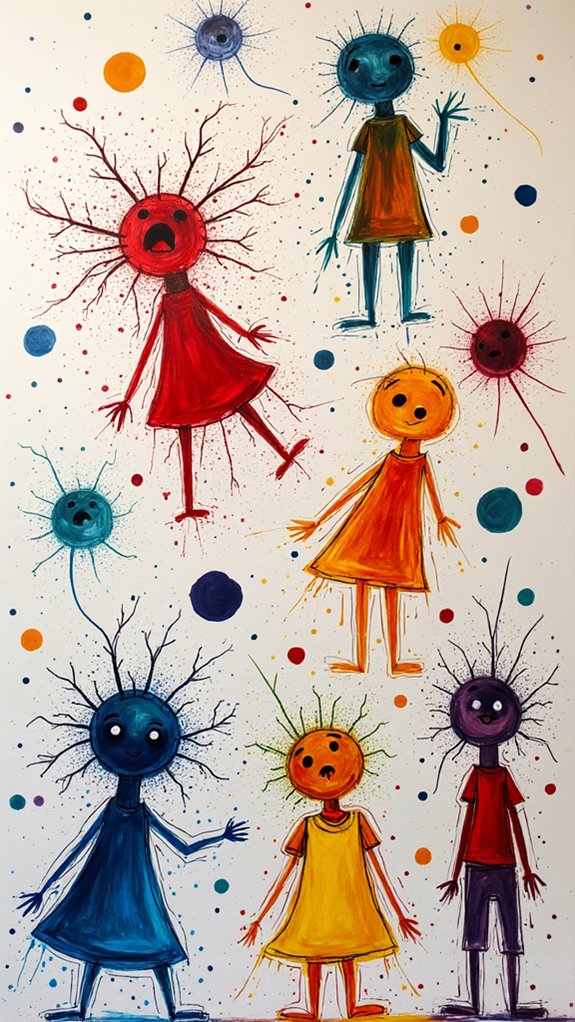
Starting with a random blob on paper might seem pointless, but it’s actually the first step in a magical creative journey!
The humble blob—seemingly meaningless scribbles that hold the secret key to unlocking your creative universe!
Those shapeless splotches can transform into amazing characters through blob transformation techniques that artists have used for years. By embracing spontaneous creativity methods, anyone can turn abstract shapes into characters bursting with personality traits!
- Draw random blobs without thinking, letting your hand move freely
- Look for hidden faces or features within the blob’s outline
- Add eyes, mouths, and limbs where the blob’s shape suggests them
- Refine the character by enhancing its unique quirks
- Give your blob-character a name and backstory based on its appearance
This process works because our brains naturally seek patterns in chaos, making character creation a thrilling adventure of discovery rather than a stressful planning exercise!
Rhythm And Music Visualized In Lines
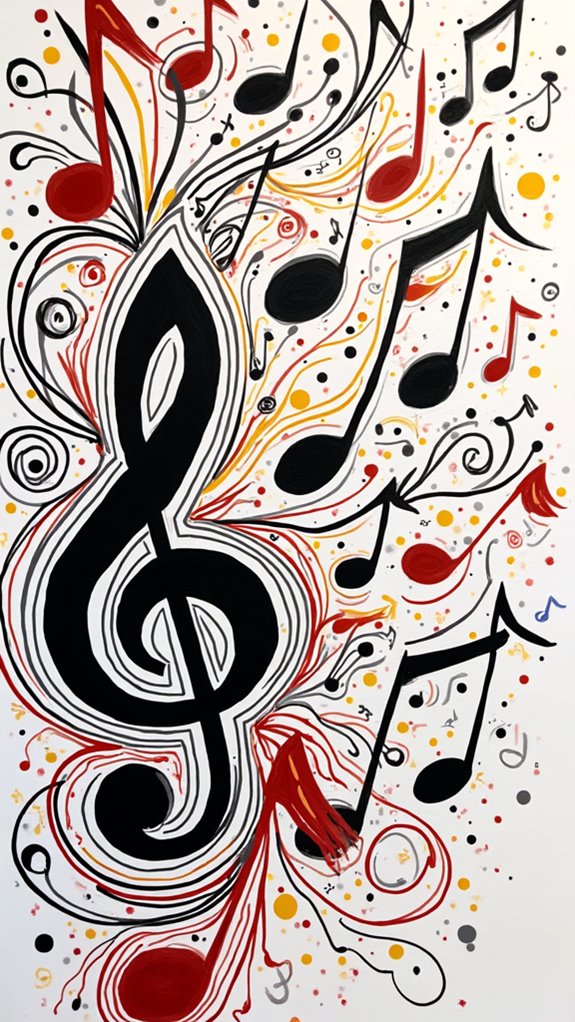
Have you ever noticed how music seems to flow through your body, making you want to move and sway? That feeling can be captured in doodles through wavy lines and patterns that dance across the page. When visualizing rhythm, your pen becomes an extension of the beat!
Different musical genres inspire unique line styles. Rock music might call for sharp, jagged lines that burst with energy, while classical melodies flow in gentle curves.
Try varying your line thickness too – bold, thick marks for powerful drum solos, and delicate thin lines for soft piano notes.
Create rhythmic patterns by repeating shapes that match the tempo of your favorite songs. Add splashes of color to express the mood – bright reds for exciting beats or cool blues for calm tunes.
Your doodles can literally become music for the eyes!
Impossible Objects And Optical Illusions
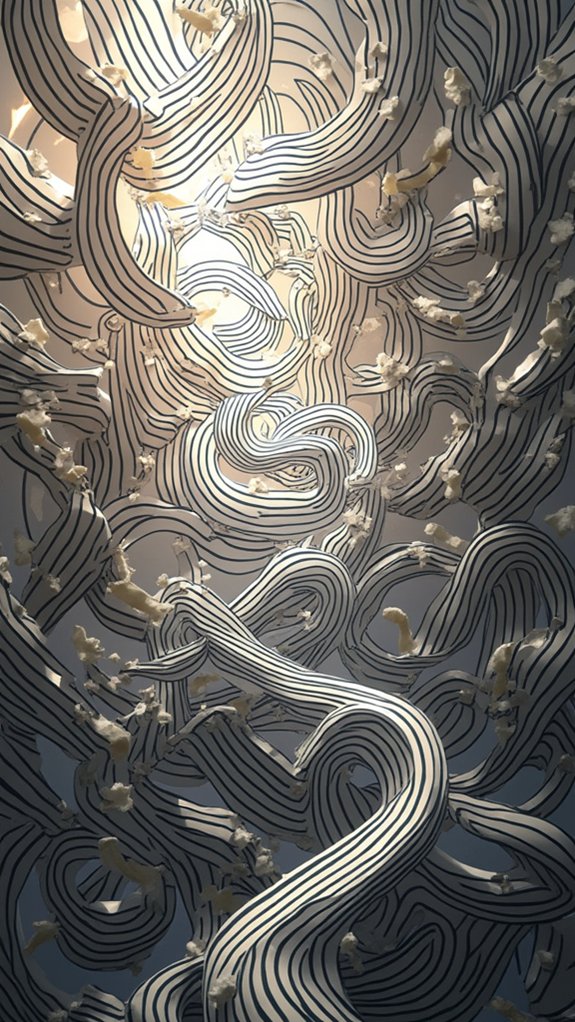
The brain loves to be tricked! Impossible objects and optical illusions create mind-bending doodles that challenge perception and spark creativity.
Our minds delight in visual puzzles – they twist perception, ignite imagination, and transform ordinary doodles into extraordinary experiences.
Drawing visual paradoxes like impossible triangles or never-ending staircases exercises the imagination while creating fascinating artwork that seems to break the laws of physics.
- Try drawing a Penrose triangle that appears to loop forever
- Create buildings with weird perspectives that couldn’t exist in reality
- Design Escher-inspired stairways that go up and down simultaneously
- Draw objects that seem to change direction when you look at different parts
- Sketch creatures that transform into other shapes as your eye moves across the page
These puzzling illustrations aren’t just fun to create—they’re also fantastic conversation starters!
When your friends try to figure out how your doodles work, you’ll enjoy watching their brains struggle with the visual tricks you’ve designed.
Dream Landscape Scapes From Memory
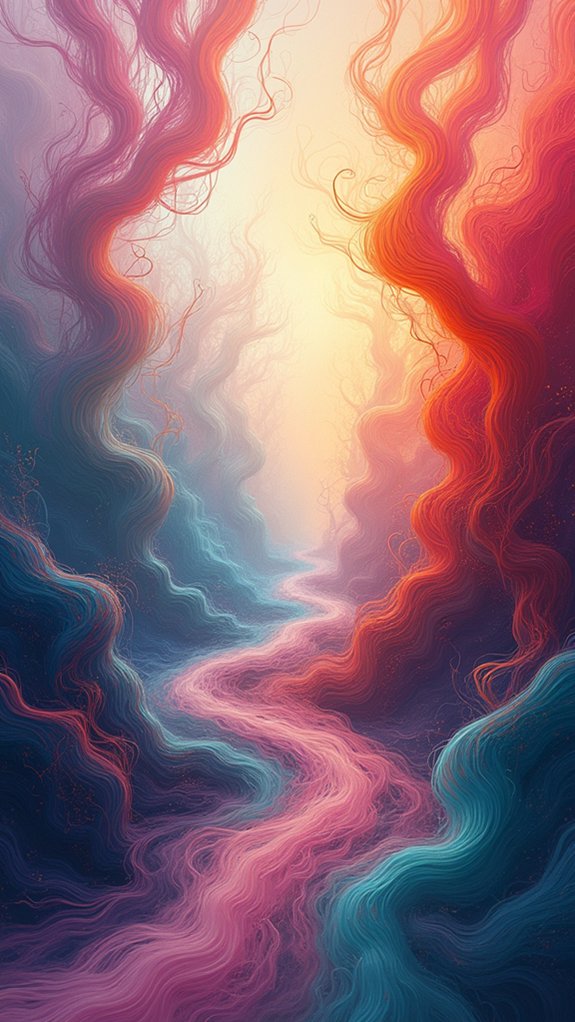
Dreams offer the perfect inspiration for creating surreal vistas that exist only in your imagination! Drawing these memory terrains allows artists to express hidden thoughts and feelings through whimsical doodles that break the rules of reality.
Begin with simple outlines of familiar elements like mountains or clouds, then let your pencil wander freely across the page.
Add emotional textures by varying your line weight—pressing harder for important dream elements and lighter for fading memories. Subconscious symbols often emerge naturally in these drawings, revealing connections you might not consciously recognize.
Play with colors that match the mood of your dream: bright oranges for exciting adventures or cool blues for peaceful underwater worlds.
These dreamscapes become personal visual diaries, capturing fleeting moments that might otherwise disappear with the morning light.
Tiny Universe In A Corner: Detailed Micro-Doodles

When artists shrink their creative vision down to the smallest corner of a page, magical micro-worlds begin to emerge! These tiny universe micro-doodles transform limited space into intricate cosmic sceneries full of wonder.
Using fine-tipped pens, artists create miniature celestial patterns that captivate the eye and calm the mind.
With each delicate pen stroke, tiny celestial worlds emerge—miniature galaxies dancing across paper, inviting viewers into their tranquil cosmic embrace.
- Stars no bigger than pinpoints forming tiny galaxies swirling in corners
- Microscopic planets with surprising detail in their rings and surfaces
- Delicate intricate line exploration creating texture and dimension
- Hidden creatures or characters nestled among asteroid-like shapes
- Geometric patterns that flow and connect like cosmic energy waves
The beauty of these micro-doodles lies in their meditative creation process. As artists focus on adding tiny details, they often enter a peaceful state, making this form of doodling both creative and surprisingly relaxing!
Shadow And Dimension With Simple Hatching Techniques
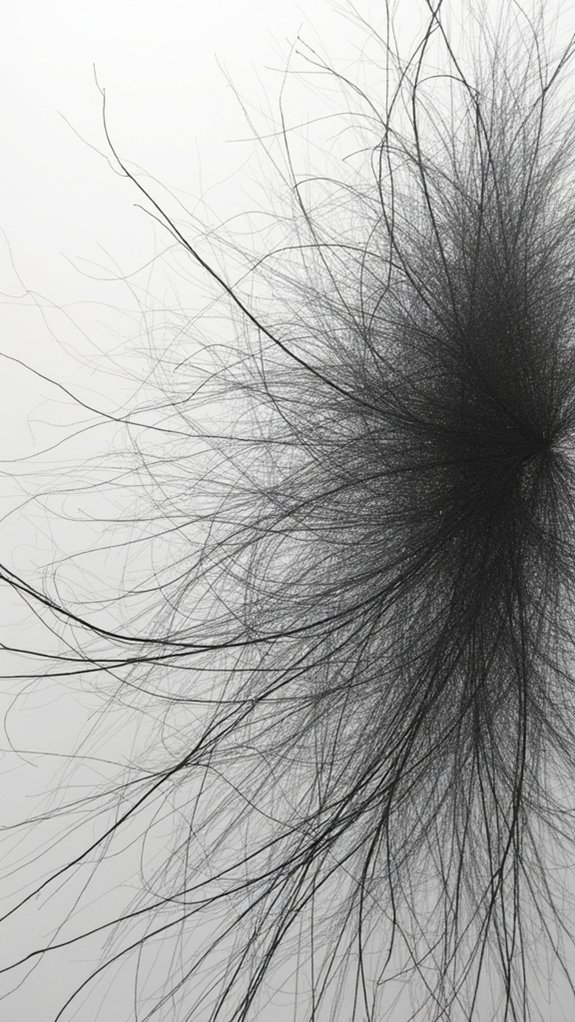
Transform your flat doodles into alluring three-dimensional art with the simple magic of hatching techniques! By drawing closely spaced parallel lines, even the plainest shapes pop off the page with newfound depth. Kids love watching their cartoon characters suddenly look real enough to grab!
Hatching techniques come in fun variations, like cross-hatching, where lines crisscross to create darker shading effects. The closer together your lines, the darker the shadow appears!
Playing with line direction adds texture too—curved lines can make a ball look round, while straight ones might show a flat surface.
Practicing line control through hatching builds serious artistic skills while looking totally cool. Try adding shadows to your favorite doodle characters and watch them jump to life with dimension!
Frequently Asked Questions
What Is It Called When You Draw Random Shapes?
Drawing random shapes is commonly referred to as doodling, an abstract expression of spontaneous creativity. This practice allows for subconscious expression through unplanned marks, revealing inner thought patterns without conscious intent.
What Does It Mean When You Doodle Zigzag Lines?
Zigzag doodles often reflect subconscious thoughts related to energy or tension. This creative expression may indicate restlessness, playfulness, or a need for movement. Zigzag symbolism frequently represents dynamic emotional states or spontaneity.
Why Do I Keep Doodling Lines?
Repetitive line doodling offers cognitive doodling benefits through subconscious creative expression. This mindfulness practice helps process information, reduce stress, and engage both hemispheres of the brain during otherwise mundane activities.
What Are the 5 Styles of Doodling?
The five doodling styles include abstract, pattern-based, Zentangle, illustrative, and Op-Art approaches. Each technique offers unique benefits of spontaneous art while providing creative drawing prompts for different artistic expressions and mental states.
Conclusion
Doodling isn’t just for passing time—it’s a doorway to your imagination! These random ideas show how simple lines can transform into stunning art that expresses your unique creativity. Whether you’re swirling through cosmic galaxies or hatching shadows into existence, remember that there are no mistakes in doodling, only unexpected adventures. So grab your pen, let your hand wander, and watch as your spontaneous scribbles become something amazing!

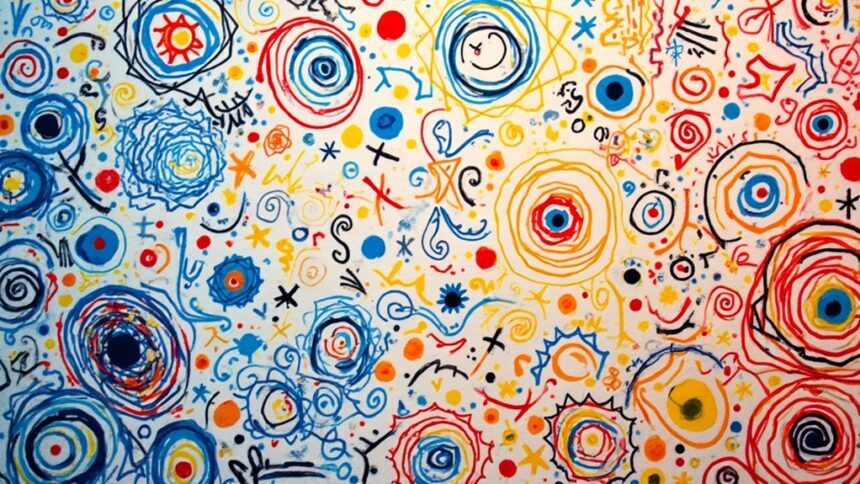
Leave a Reply